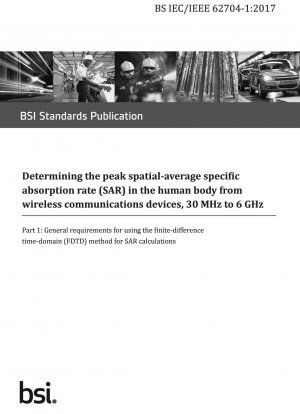BS IEC/IEEE 62704-1:2017
Determining the peak spatial-average specific absorption rate (SAR) in the human body from wireless communications devices, 30 MHz to 6 GHz - General requirements for using the finite-difference time-domain (FDTD) method for SAR calculations
- Standard No.
- BS IEC/IEEE 62704-1:2017
- Release Date
- 2020
- Published By
- British Standards Institution (BSI)
- Latest
- BS IEC/IEEE 62704-1:2017
- Scope
- What is BS IEC/IEEE 62704-1- Finite difference time domain (FDTD) about? BS IEC/IEEE 62704-1 is a safety standard on determining the peak spatial-average specific absorption rate (SAR) in the human body from wireless communications devices. BS IEC/IEEE 62704-1 defines the methodology for the application of the finite difference time domain (FDTD) technique when used for determining the peak spatial-average specific absorption rate (SAR) in the human body exposed to wireless communication devices with known uncertainty. BS IEC/IEEE 62704-1 defines methods to validate the numerical model of the device under test (DUT) and to assess its uncertainty when used in SAR simulations. Moreover, BS IEC/IEEE 62704-1 defines procedures to determine the peak spatial-average SAR in a cubical volume and to valid...
BS IEC/IEEE 62704-1:2017 history
- 2020 BS IEC/IEEE 62704-1:2017 Determining the peak spatial-average specific absorption rate (SAR) in the human body from wireless communications devices, 30 MHz to 6 GHz - General requirements for using the finite-difference time-domain (FDTD) method for SAR calculations
